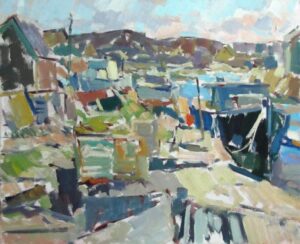At one of my always stimulating dinners with my late friend Zyg Jankowski, he said to me that the first decision a painter has to make about his work is a spacial one: how “deep” do you want to make the picture? John Carlson felt that every foot into nature counted; Ed Whiney had no interest in such realistic depth and recommended a student plan the composition on-site but walk around a corner to paint it. Over the years, I’ve been schizophrenic about the question. Under Emile Gruppe’s tutelage, I naturally followed Carlson’s path. Later, I experimented with a flatter approach , one which, carried to an extreme, can make the subject disappear in a series of flat planes.



Note: for a further discussion of these points, check out YouTube:
Michael Chesley Johnson PSA MP says
Charles Movalli has always been one of my very favorite painters. It’s good to read this thoughts here.
Malcolm Allsop says
Charles in an inspirational painter and had many fans here in the United Kingdom. I just wish he has committed some of this to a teaching DVD at some time. Wouldn’t that be great?
Movalli says
M: Oh-oh–“had” fans, eh? My wife keeps telling me that I’ve fallen into total obscurity. At least I’m not mobbed at the mall. But that’s actually a plus when it comes to being an artist: No one over here would have recognized Andrew Wyeth, and I bet Ken Howard could could eat your undercooked bacon in any restaurant in the UK and remain anonymous! CM
Malcolm Allsop says
Sorry Charles. Fat finger typing on my part. Very much “has “. I think IPads were designed for people with brain surgeon fingers – which lets me out. We are the UK’s fastest growing producers of top end fine art DVDs and we would love to work with you. I first saw you on the Stobart public TV series which I bought on DVD years ago!
Marsha McDonald says
Oh, WOW! I would jump at a chance to see Charles Movalli do some demos on
DVD, Malcolm. Do what you must to convince him, PLEASE! I am a painter,
who has also collected some of his work.
Are you reading this, Charles???
Movalli says
Marsha: opps: I took my eye off the blog–and you wrote a comment! At one time, I pledged to be the only artist in America without (1) a limited edition print (now a “giglee”), (2) a book (having perpetrated many in my misspent youth)), and (3) an instructional video (now a DVD). So far, so good! CM
Ingrid Hemphill says
Part of the DVD could be a discussion/slide lecture of painters who have inspired you. Part of it could be a visual list of supplies. You wouldn’t even have to face the camera much. A series of the process of beginning paintings with your back to an observing class would be great. A walk around a gallery talking about composition, etc. would be great. A documentary style DVD would help to continue the New England tradition of landscape painting. Missionary work! Your students would really appreciate it.
Greg Popa says
Charles,
I’d like to contact you about one of your paintings on Mt. Mansfield. My email is gpopa@myfairpoint.net
Best, Greg Popa
Editor, Stowe Guide & Magazine